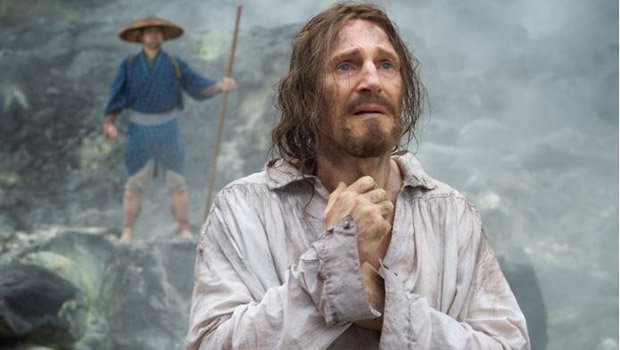Silence is, despite any reservations viewers might have about its narrative, undeniably beautiful. And, despite my explicit secularity, Silence spurred awe and contemplation from me.
Martin Scorsese’s newest film takes us to 17th-century Japan, where two Portuguese Jesuit priests (Andrew Garfield and Adam Driver) are tasked with finding Father Cristovao Ferreira (Liam Neeson), a third priest, rumoured to have apostatised.
Yosuke Kubosuka’s portrayal of Kichijiro, a Japanese man who is tormented by the notion of his selfishness and apparent lack of will being in opposition to his outlawed Christian belief, epitomizes the existentialism of the film.
Silence has two modes: The first is suffering. There are multiple scenes of torture in the film, which were, to be perfectly honest, hard to sit through. The Japanese soldiers at one point crucify Christian villagers on the beach, where they are eventually drowned by the unceasing waves of the incoming tide. Fathers Sebastiao Rodrigues (Garfield) and Fransisco Garupe (Driver) are forced to watch, from a hidden vantage point, helpless and in silence.
Later, on that same beach, Rodrigues is captured and told to apostatize or Japanese Christians who have refused to apostatize will be burned alive. A man of faith, Rodrigues refuses. And we, along with him, are forced to watch entire families burn on pyres.
The film lacks a musical score, so that during these scenes of torture and suffering, we are forced to confront the pain of characters on-screen. We drown in their screams just as they drown on their crucifixes on the beach, while they burn, while they are rolled in bamboo mats and pushed into the sea. These scenes of torture are almost unbearably long, and always, they are followed by silence. We are left to take in the horrors, and consider the depth of faith that must have driven the characters on-screen to stick to their beliefs so unquestioningly.
Scenes of persecution and torture are punctuated by sweeping shots which highlight the natural beauty of the Japanese landscape. Mountain-ranges, beaches, even the forests of the country are highlighted. (Perhaps unnecessarily, however.) Because although the beauty of these shots is undeniable and breathtaking, they do nothing to add to the story, other than perhaps give viewers a reprieve from the violence which throughout the film becomes increasingly difficult to stomach.
The introduction of Liam Neeson’s Father Ferreira comes rather late in the story and serves to open our eyes to, (we think) a new mode of thought in the narrative, outside that of strictly Christian-backed dialectic. At this point, we’re numb to cruelty, having witnessed it extensively throughout.
The film highlights Ferreira’s newfound Buddhist piety (to Rodrigues’ dismay) after having shown us faith through a purely Christian lens. This, interspersed with more scenes of torture, and punctuated by Ferreira’s musings on theology, would have driven a point home about the equality of faith across religious landscapes. But that, we know, is not reflective of the truth of human action.
Ferreira’s story, told through a prolonged flashback, highlights the arrogance of missionaries while managing to humanize them, a feat not overlooked by the narrative. We’re asked questions; must faith be proclaimed in order to be practiced? Whose faith is legitimized within the dichotomy of an oppressor and an oppressed? Whose oppression is justified? Whose faith, after such long hardships, remains pure?
The answer is given in the very last shot, and, despite its implications, we are met, invariably, with silence.


